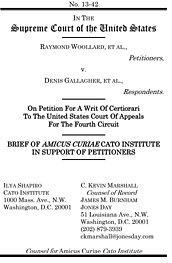Woollard v. Gallagher
Learn more about Cato’s Amicus Briefs Program.
For anyone who has watched The Wire, it’s no surprise that Maryland (Baltimore, in particular) has one of the highest rates of violent crime in the country. In an alleged effort to address this persistent problem, the state requires an applicant for a license to carry a handgun to demonstrate “a good and substantial reason to wear, carry, or transport a handgun as a reasonable precaution against apprehended danger.” Under this prove-it-to-use-it standard, Baltimore County resident Raymond Woollard, who had had a license to carry for six years (after a violent home invasion), was denied a license renewal because he could not document that he had been threatened recently. The fact that he had been attacked by his son-in-law seven years earlier, an event to which it took law enforcement two-and-a-half hours to respond, was insufficient to meet Maryland’s special-need requirement. Woollard, along with the Second Amendment Foundation, thus brought suit challenging the law under the Supreme Court’s recent decisions in District of Columbia v. Heller (2008) and McDonald v. Chicago (2010). Although the district court ruled for Woollard, finding that Maryland’s restriction violated the Second Amendment, the U.S. Court of Appeals for the Fourth Circuit overturned the lower court and reinstated the law. The court purported to apply “intermediate scrutiny,” which allows a challenged statute to survive only if it is “substantially related to the achievement of an important governmental interest,” but in fact, hardly applied any scrutiny at all. The court’s analysis was both circular and contemptuous of Heller, finding that a regulation is “substantially related” to the valid government interest of curtailing criminal gun violence if it merely reduces the number of citizens lawfully carrying handguns, thus accepting the state’s implicit argument that the right to bear arms was itself the problem, one that should not be overcome without “a good and substantial” reason. Cato has filed a brief supporting the plaintiffs’ request that the Supreme Court review the case and clarify that the Second Amendment protects more than the right to keep a gun in one’s home. The deferential approach that the Fourth Circuit took here mirrors the weakened scrutiny applied in the Second Circuit’s decision in Kachalsky v. Cacace, in which Cato also filed a brief. In Kachalsky, the court upheld a New York law requiring applicants for a carry license to show “proper cause.” Instead of requiring the state to demonstrate a concrete connection between the restriction and crime prevention, the court deferred to the political branches’ “discretionary judgment” on the issue. However, other courts have expounded different doctrines since the Supreme Court ruled in Heller that the Second Amendment protects an individual right. For example, the Chicago-based Seventh Circuit demands that a restriction on Second Amendment rights satisfy a heightened level of scrutiny that requires “an extremely strong public-interest justification and a close fit between the government’s means and its end.” This confusion between lower courts lies at the very heart of the definition of Second Amendment rights outside of the home, and is in dire need of clarification. As with all other constitutional rights, the political branches cannot limit the exercise of Second Amendment rights to those who can demonstrate some “special need.” Whatever standard may ultimately govern, this case provides an ideal opportunity for the Supreme Court to reaffirm what the district court said in this case about Woollard’s exercise of the constitutional right to armed self-defense: “The right’s existence is all the right he needs.”

